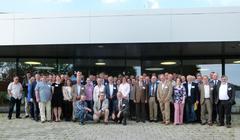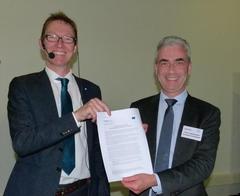URL: https://www.desy.de/news/news_search/index_eng.html
Breadcrumb Navigation
DESY News: EU and Russia are preparing to collaborate more closely in the field of research infrastructure
News
News from the DESY research centre
EU and Russia are preparing to collaborate more closely in the field of research infrastructure
Russia and the European Union want to collaborate even more closely in the future in the field of large-scale research infrastructures. That was the clear signal sent at the closing conference of the European-Russian project CREMLIN, which took place on 5 June 2018 at DESY in Hamburg.

More than 70 participants attended the CREMLIN closing conference at DESY (photo: DESY/M. Kreuzeder).
The five Russian projects are the heavy ion collider NICA at the Joint Institute of Nuclear Research in Dubna, the research reactor PIK at the Petersburg Nuclear Physics Institute PNPI NRC KI in Gatchina, the high-energy laser facility XCELS at the Institute of Applied Physics in Nizhniy Novgorod, the lepton collider Super Charm-tau Factory at the Budker Institute in Novosibirsk, and a new, fourth-generation synchrotron radiation source, SSRS-4, at the Kurchatov Institute in Moscow. In the course of the project, the European and Russian partner laboratories not only analysed and demonstrated the potential for collaboration with these five large new Russian research facilities, but also worked out detailed proposals as to what schedules for collaboration they intend to pursue over the next ten or so years.
“Since the very first day of the joint European-Russian initiative CREMLIN, all participants have shown their strong commitment to establish a close cooperation within the Russian Megascience projects. For me and my colleagues at the NRC Kurchatov Institute it was a nice experience to collaborate so closely with DESY and the European partners,” said Vladimir Kravchuk from the Kurchatov team, who supported the coordination of the project from the Russian end.

Pierre Quertenmont from the European Commission (right) receives the recommendation document from CREMLIN project manager Martin Sandhop (photo: DESY/M. Kreuzeder).



